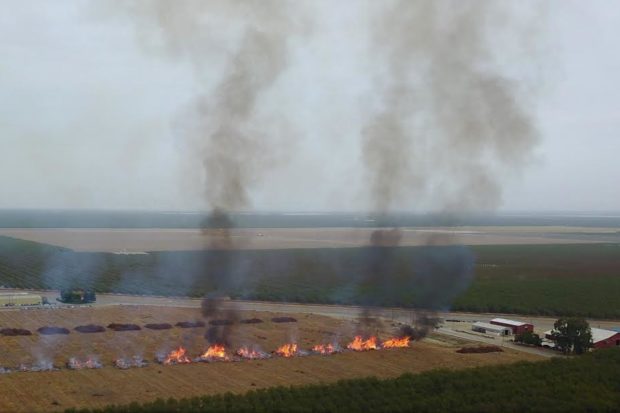
By Tom Frantz
On Nov. 7 and 8, a Biomass Summit was hosted by the San Joaquin Valley Air Pollution Control District at the Kearney Agricultural Research and Extension Center in Parlier. The purpose was to solicit information about methods and technologies that deal with agricultural biomass such as almond trees produced during orchard removal.
There are around a million acres of almond orchards in the San Joaquin Valley. About 4% of that acreage, or 40,000 acres, is removed annually. This produces 1.2 million–1.5 million tons of biomass each year.
Farmers used to push over their old trees and burn them in the field. This is called “open burning.” But SB705, which was sponsored in 2003 by State Senator Dean Florez, prohibited this practice because it was polluting. A ratepayer subsidy was put in place for incineration of shredded trees at biomass-fueled power plants. This was considered cleaner because of the more controlled burning process, but emissions of pollutants were still high, especially compared to power plants fueled by natural gas. The electricity produced from biomass is considered 100% renewable even though current methods of growing almonds use massive fossil-fuel-based inputs such as fertilizers, machinery and irrigation water.
The electricity subsidy expired recently for several of the biomass facilities, and they have shut down. The farmers could not afford to pay the full cost of shredding and trucking their wood to these facilities and the negative costs of running them. Consequently, farmers have been requesting special permits to burn in the fields again with economic necessity as the excuse.
There are some who like to call this biomass a waste product in need of disposal. There were several business representatives pushing their innovative waste solutions at this Biomass Summit. These businesses, lumped together, are commonly called the biomass industry. Some of them build and operate dirty polluting biomass incinerators such as the Rio Bravo Fresno plant in Calwa. Others promote the high-tech processes used in pyrolysis incinerators or gasification boilers that burn the biomass without oxygen producing both a gas for burning as a fuel and a residue of charcoal (biochar for the hippies). These are slightly less polluting than the traditional biomass incinerators, but they will still pollute our air if put into widespread use. One company rep described his portable burners, which would incinerate the whole trees locally but more cleanly than open field burning. All these solutions would rely on a subsidy to operate affordably.
But there were other presenters at the summit who were not trying to sell something. They were state officials, agricultural researchers and environmental justice advocates.
One presentation showed that damage to health in the San Joaquin Valley was equally bad with both the open burning and the traditional biomass incinerators. This is because even though the biomass incinerator is less polluting there are more people living closer and they burn 24 hours per day for the entire year. Basically, we know that burning of any type is not a good solution for the polluted San Joaquin Valley and there is no dirtier or less efficient way to make energy.
The ag researchers fortunately have studied alternatives to burning this biomass. Namely, they have looked at shredding the trees and rototilling the wood into the soil before planting a new orchard. The cost is around $1,200 per acre, so it is not cheap. But these researchers have studied this for nine years already and have seen $1,500 in increased yields because of the soil improvements during the first half dozen years of a new orchard. They have also measured more than $500 worth of retained nutrients that benefit the new crops. These researchers showed plainly that there is no need for burning of any kind with the fact that whole orchard recycling gives a positive economic return.
The environmental justice advocates at the summit agreed that returning this clean and nutrient laden biomass to the soil is the best option for decreasing air pollution. It also has the co-benefits of both sequestering carbon in the soil and decreasing fossil-fuel-based inputs. So there is a clear global warming benefit, and no public subsidy is necessary.
Seyed Sadredin, chief of the air district, concluded the meeting by saying he liked one of the portable gasification proposals despite the fact it was not close to being commercially available and would require expensive subsidies forever. It didn’t make any sense.
In the end, it looks like farmers will do what is best for them and their crops. They realize, as one farmer representative concluded, that dependence on subsidies is not a sustainable solution because they always disappear. Putting their own biomass to good use in growing new crops seems to be the obvious solution. The public hopes the state is listening and that subsidies to other polluting processes are not approved.
*****
Longtime clean air advocate Tom Frantz is a retired math teacher and Kern County almond farmer. A founding member of the Central Valley Air Quality Coalition (CVAQ), he serves on its steering committee and as president of the Association of Irritated Residents. The CVAQ is a partnership of more than 70 community, medical, public health, environmental and environmental justice organizations representing thousands of residents in the San Joaquin Valley unified in their commitment to improving the health of Californians. For more information, visit www. calcleanair.org.
